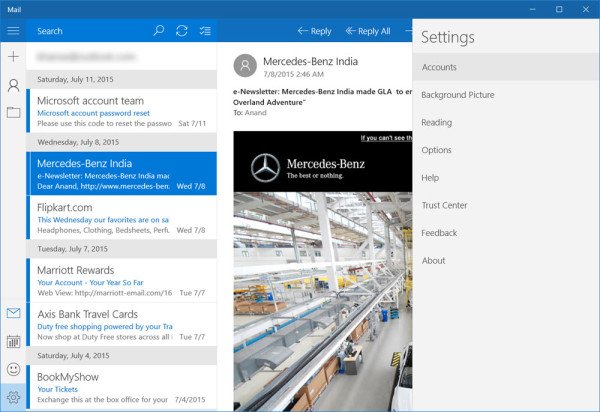Microsoft has been making a lot of improvements to the Mail app in Windows 11/10. It has gone from mediocre to a very capable app. In this post we will see is new features, how to create or add a new email account, create a signature, how to use it to send & receive email, etc.
The mail app is a stripped-down version of the Outlook app found on the web and in the Office. It comes with all the essential features that users would need to check their mail and reply to a sender, so it should be okay for most users. But for those on the advanced side of the spectrum, might need a lot more.
How to use Windows 11/10 Mail app
Launching the mail app for the first time doesn’t throw users right into their email. It comes up with a Get Started button, along with the option to choose your account. Once that is done, the user will be brought to the inbox and from there they can read the latest email.
Let’s talk about how to use this decent enough Mail app.
With the Windows Mail app, users can add several mail accounts from other providers such as Google, Yahoo, iCloud, a second Outlook account and more via POP 3 or IMAP.
Read: Best Free Email Clients for Windows PC.
Create or add new email account in Windows Mail app
If you are using Microsoft Account to sign in to your Windows PC, the Mail app will automatically create your mail account. If you are using a Local Account, then you can create a new email account in the Windows 10 Mail App as follows: Open Mail app > Click on the Switch to Settings gear icon in the bottom left corner > Click on Accounts in the Settings panel which pops up from the right side. Now click on Add an account.
A new window within the Mail app should now be visible. From here all users should see “Choose an Account”, and below it are all the mail accounts users can add. For the ones that are not available, they can only be added via POP 3 and IMAP.
To add other email accounts from POP and or IMAP, we suggest checking if POP and IMAP have been activated in the mail account you might want to use. If they are not, make sure to do so before trying to add them to the Windows 10 Mail app.
We should point out that if your Outlook mail account already has other mail accounts added beforehand, there should be no need to add them all over again. Just click on the “More” button below “Inbox” to get access to these accounts.
Right-Click on your favorite account to pin it to the Favorites section or to the Start Menu. You can also add multiple Live Tiles for multiple Email Accounts.
Back to the Settings section. You might have noticed a button that says “Background” last time around. Yes, that’s exactly what it means, you can change the background from the dull blue cloud-looking picture to anything that fits your mood today.
In the Reading option, users can change how the app marks emails as read, along with opening the next mail automatically.
In the Options section under Settings, users have the ability to customize the Swipe options. This is designed for folks using a touch-enabled Windows 10 machine.
Users can also change the signature, and customize what happens when a mail is received. For example, the Mail app can play a sound, and show a notification banner which when clicked on, will launch the app if it is closed.
Overall, the Windows Mail app experience is basic and nothing exceptional. There’s no way right now to highlight multiple emails with just a single click for deletion, something that every Mail app should have.
TIP: This post will help you if you cannot open Mail and Calendar app.
Some of you might want to also read this post on Windows Mail app tips and tricks. See this post if Windows Mail and Calendar app freezes. This post will show you how to add an alternate calendar in Mail & Calendar app in Windows 11/10.
Next: Read about the Windows Calendar App.
